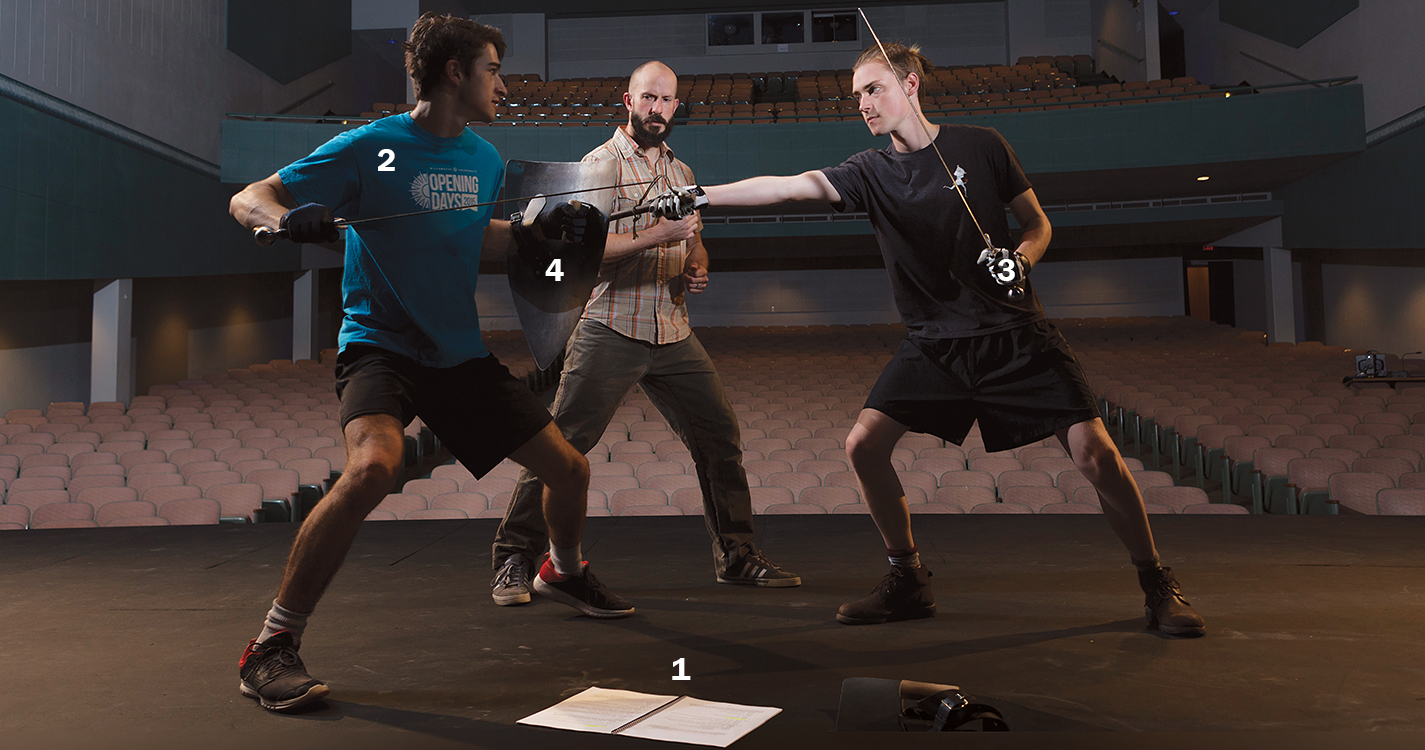As Jonathan Cole stands on stage in Willamette’s Smith Auditorium, a student lunges at him. The student wants to kill him — and Cole is going to show him how.
Cole, an associate professor of theatre, is one of only 162 fight directors nationwide certified to teach stage combat. From Shakespeare’s bloody battles to modern-day cultural conflicts, violence in theatre can take center stage. Whenever a performance requires actor-to-actor contact — hitting, sword-fighting, even intimacy — directors call Cole.
“This work combines everything we do as theatre artists,” he says. “It’s acting, storytelling, an understanding of space and lighting.”
In slow, graceful, dance-like movements, Cole (center) and the student rehearse how to battle and kill an opponent. For one 40-second sequence, the actor memorized dozens of intricately choreographed moves. After numerous practices in slow-motion, he’ll later perform the moves faster, in costume and without do-overs.
Cole draws on historical research and sleight-of-hand tricks to teach actors how to do everything from throw knives to gouge eyes in a safe, visually effective way. Early in rehearsal, actors will sometimes fence with pool noodles to generate choreography.
Safety for actors and the audience is Cole’s primary concern, and he analyzes every weapon used onstage. For new firearms, he must know in what direction blanks will fire, how much hot gas shoots out and where shells scatter. He says, “The gun is a character in and of itself, and it needs its own space.”
Cole remembers an incident in an Austrian theatre where a professional actor in a suicide scene unwittingly slit his own throat with a knife blade that hadn’t been blunted. Fortunately the actor survived. Accidents like that, Cole says, are “why careers like mine exist.”
Some of the tools Cole uses to make fights a dramatic experience
1. Script
Cole’s script analysis guides more than fight choreography. For his dark vision of Willamette Theatre’s recent production of Macbeth, Cole wanted actors to appear formidable, with days-old grit on their faces and loose clothing to accommodate fight moves. In his production notes, he said the set should feel damp and cold, “like the Oregon coastal woods.”
2. Body
An actor’s body influences fighting styles. As student actors in Macbeth weren’t burly like the mature fighters they portrayed, Cole used martial arts principles to develop the scenes. Students Will Bremer ’18 (left) and William Forkin ’19, learned Japanese broadsword techniques that best fit their body type and provided the speed Cole sought.
Fights also reflect a director’s perspective on a character’s emotions, motive and personal history. The student playing Macbeth, whom Cole viewed as a superior swordsman and tactician, fought with more finesse than his emotionally raw opponent, Lord Macduff, who was avenging the death of his family. Practice makes perfect, too — the cast devoted 40–50 hours, or one-third of total rehearsal time, to fight sequences.
3. Weapon
Stage weapons are modified or designed for safety. Cole’s training covers techniques for use of firearms, the broadsword, rapier and dagger, single sword, broadsword and shield, smallsword, knife and quarterstaff, as well as unarmed combat.
4. Shield
Safety and artistry aren’t the only elements a fight director considers for a scene. Shields of armor can double as drums. When a character parries, Cole notes the rhythm and syncopation of the weapons.
This article was originally published in the fall 2017 issue of Willamette magazine.

